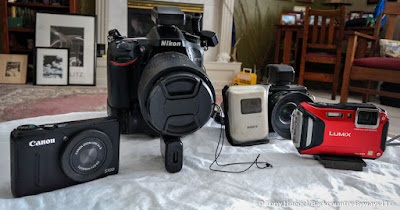In the days when we shot photographic film for our wildland-travel guidebooks and magazine features, it could be difficult months or years later to match an image with a dirt road or other feature we needed to depict.
 |
| GPS-equipped cameras and accessories |
That’s because photographs of deserts, mountains, plains, forests and such often lack features that make exact location unclear.
So, since adopting digital imaging many years ago, we’ve put considerable effort into acquiring cameras and accessories that can embed GPS (global positioning system) data into our photographs.
The digital cameras above -- from the pocket camera on the left to the DLSR in the center and the “tough” compact on the right -- will do so.There were times, in fact, when we’d study a USGS topographic map, and match landscape and terrain contours and features in a photograph with those on the map to identify a photo’s location.
The digital cameras above -- from the pocket camera on the left to the DLSR in the center and the “tough” compact on the right -- will do so.There were times, in fact, when we’d study a USGS topographic map, and match landscape and terrain contours and features in a photograph with those on the map to identify a photo’s location.
In our wildland-travel service today, we provide GPS-guided routing along remote backcountry roads that often lack distinctive, unique features. And we use photographs to show our clients the exact roads and terrain on which they’ll be traveling. This can include potential obstacles and their precise location.
While any smartphone can include GPS location data with a photo, that is a rare feature of even today’s most advanced, dedicated, stand-alone cameras. That’s because few cameras -- even those intended for travel photography -- have built-in GPS sensors.
The long-discontinued Canon S100 pocket camera on the left in the photo has a built-in GPS sensor. It will embed location data and even record a track of our travels for download later. So does the Panasonic Lumix DMC-TS6 “tough” camera on the right. There was nothing extra to buy for either camera, and the function is automatic. (GPS is standard in the “tough” camera genre intended for rugged outdoor use. It should be as well with all cameras today, as it is with smartphones.)
The Nikon D7100 DSLR and the Panasonic Lumix LX7 compact in the photo each have external, third-party GPS photo loggers as accessories.
On the Nikon, we use a hot shoe-mounted Solmeta Geotagger N3-C that writes the GPS data directly to each image. It is highly sensitive to satellite signals, accurate, and reliable.
On the LX7 in the background, we use a long-discontinued, hard-to-find Sony GPS-CS3 accessory (the little white thing). It can be used with any camera that uses an SD memory card, and attaches to a camera’s strap (we keep a second on our SUV’s dashboard). Similar units by other manufacturers are available.
The Sony unit works by syncing the clock in one’s camera with the clock in the CS3. When shooting is done, just insert the camera’s SD card into the CS3, choose “Match” from the menu, and the CS3 will write the GPS data it recorded into each image on the card. It does so by matching the time the photo (camera clock) with the continual GPS time and location recorded by the CS3's internal clock. (It holds a single AA battery, and it must be monitored, for the battery doesn’t last long. Its GPS sensor also isn't as sensitive as we'd like, but it's old technology.)
The Sony unit works by syncing the clock in one’s camera with the clock in the CS3. When shooting is done, just insert the camera’s SD card into the CS3, choose “Match” from the menu, and the CS3 will write the GPS data it recorded into each image on the card. It does so by matching the time the photo (camera clock) with the continual GPS time and location recorded by the CS3's internal clock. (It holds a single AA battery, and it must be monitored, for the battery doesn’t last long. Its GPS sensor also isn't as sensitive as we'd like, but it's old technology.)
This is how we keep track of where our photographs are taken. There are other ways as well. We have an app on our phone that will sync with a camera, but we prefer our on-camera hardware solutions.
You could take a quick locator shot of the same scene with your smartphone as your non-GPS camera, but that's one more thing to do. You might also find computer software that can sync camera times with GPS tracks downloaded from a dedicated GPS navigation unit. But again, we prefer hardware. And as long as our batteries hold up (GPS consumes a lot of juice), the solutions here work for us.
This YouTube video, and this article at B&H Photo-Video, can help with your search for a suitable geotagger. The online retailer GPS Web Shop appears to offer the broadest inventory of geotaggers, also called data loggers.If you’ve had difficulty remembering where your photos were taken as the years go by, a GPS-driven solution may suit how you work. Your descendants will thank you when you and your memory have faded away ...
No comments:
Post a Comment